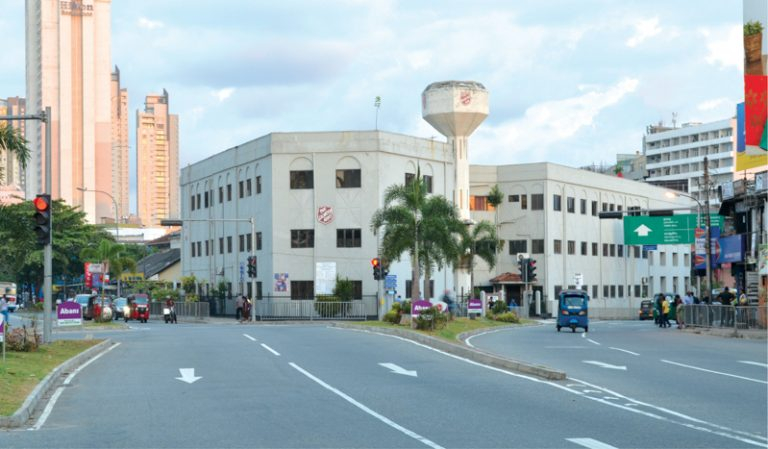
Colombo has a rich legacy dating back to the colonial era. Having evolved from a small and relatively unimportant harbour, it gradually gained prominence and grew to be the Island’s nerve centre in commerce, administration and social fabric. The story of its rise is interwoven with numerous intriguing asides. The story of ‘Company Street’ or ‘Slave Island’ is well worth the telling.
Words and Photographs Shyam Ranasinghe
The Beira Lake, a temporary repository for water draining from the Diyawanna Oya through the city of Colombo, carves out a small peninsula that stands out prominently. During the period of the Portuguese, this natural geographical barrier was exploited as it was seen to be the ideal dwelling place for the mostly African slaves brought to Sri Lanka to work as labourers. Since the area was bordered by water on three sides and the remainder was sealed off with dense if not impassable shrub jungle, this was the ideal lockup to ensure the slaves did not attempt an escape. Though the era of the Portuguese and that of forced labour is long gone, the name stuck and has survived to this day.
Slave Island, however, is referred to differently in Sri Lanka’s official languages. The Dutch (who followed the Portuguese) transformed the infamous ‘island of slaves’ into a commercial district. This brought many companies (‘compagnie’ in Dutch) to Slave Island. The streets where they were located were simply referred to as ‘Kompanna Veediya’ by the local Sinhalese and as ‘Kompaniththeru’ by the Tamil-speaking population. Though of a completely different origin and meaning to their English counterpart, the Sinhalese and Tamil names too have stuck and remain equally popular.
Modern day Slave Island is one of the main corporate hubs of Colombo. Yet it is also home to all aspects of social life that an urban Sri Lankan would expect, both multi-cultural and multi faith.
In addition to its religious importance, the Seema Malaka is also one of the most popular tourist attractions in the area
Here you’ll find some of the most venerated religious shrines of all the major faiths in the country. Along Sir James Peiris Mawatha and the banks of the Beira Lake, the iconic Seema Malaka or ‘meeting house of the monks’ is not to be missed. In addition to its religious importance, the Seema Malaka is also one of the most popular tourist attractions in the area. Barely 100 metres away lies another small islet, which has been converted to a recreational retreat with a bubble dome, and linked to the city via a picturesque suspension bridge. You can visit them on foot or take advantage of the view from the water – pedalos are available to hire for a nominal fee.
The Gangaramaya Temple, located along Sri Jinarathana Road and not far from the Seema Malaka is another major attraction for both pilgrims and tourists. The administrator of the temple’s annual Navam Perahera Festival has gained a significant degree of prominence among the Buddhist community of the country, and the place proudly displays its links with far Eastern Buddhist institutions too.
At the main junction of Slave Island, where six roads meet is the unmistakable Holy Rosary Church, popularly known as Infant Jesus. The hallowed image of the Christ Child dressed in divine royal regalia inspires affection in all, irrespective of faith. The church is modest in size but attracts an impressive number of faithful churchgoers from both near and far.
Home to many of the country’s top-end corporates, it has a wall street vibe. Union Place is another key commercial area, deriving the name from the Dutch
Also in the vicinity is the Masjidul Akbar, probably one of the oldest mosques in the area, having been built in 1864. What was originally constructed from mud and straw has grown in both stature and magnificence mainly through the efforts of the faithful, who gather in its halls to offer their prayers. Right next door is the Sri Sivasubramaniam Temple, which is lavishly decorated in honour of various Hindu gods. Honouring ancient rituals, it radiates incense, faith and friendship across Slave Island.
Nawam Mawatha, the road off Sir James Peiris Mawatha that runs along the banks of the Beira, is the corporate hub of Slave Island. Home to many of the country’s top-end corporates, it has a Wall Street vibe. Union Place is another key commercial area. Deriving its name from the era of the Dutch, it simply refers to the road that joined the residential area of Cinnamon Gardens with that of the commercial area of Colombo. Having evolved from that simple purpose, it’s now home to a corporate bubble that can easily challenge any other precinct.
Kompanna Veediya just keeps on growing. With many major construction projects already in progress, Slave Island is set to alter Colombo’s skyline forever, in the same way that it contributed to the transformation of the country’s commercial capital into a modern day metropolis.


